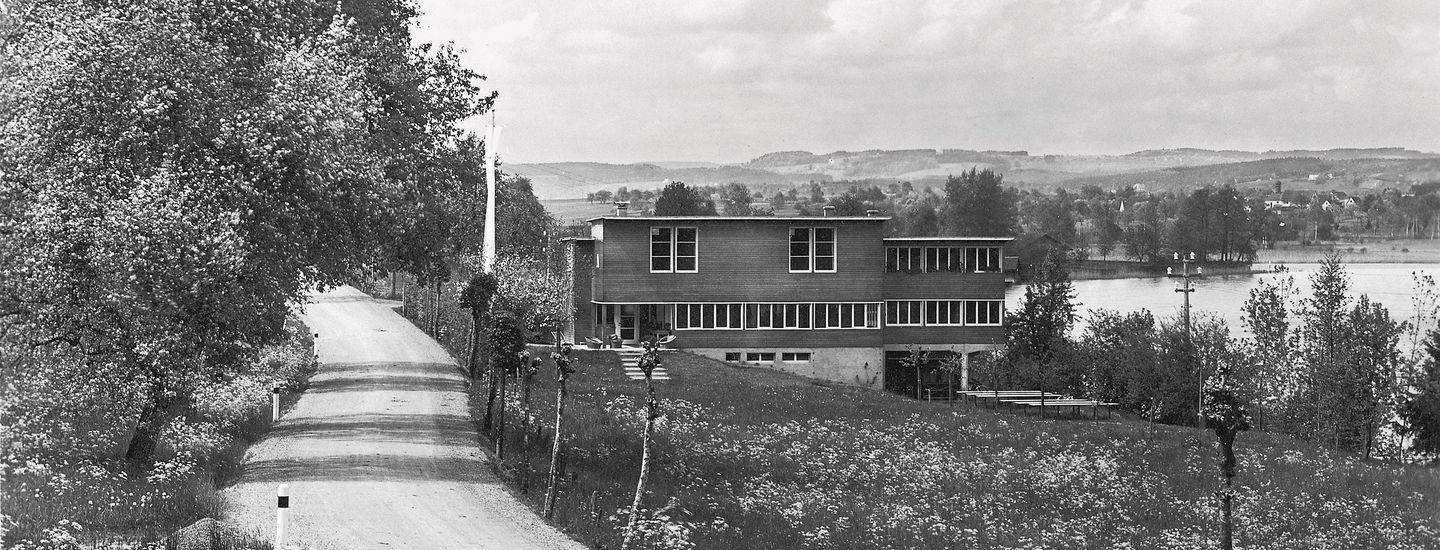
1924 to 1932
Founding years
(…) «However, more and more insightful educators pondered this strange phenomenon and finally discovered that the whole movement met an urgent need for time. They increasingly recognised the value of hiking for young people and successfully included hiking in their activity plans.»[1]
“Where do the young hikers spend the night?” – helping the Swiss youth
Shortly after 8 o'clock in the morning, the first attendees arrive at Gartenhofstrasse 1 in Zurich-Wiedikon. On this day, 28 April 1924, the plan is to implement what has been planned and discussed in recent months: The founding of the Association of Youth Hostels Zurich. The 24-year-old secretary Gertrud Zinner, an economics student from a trade union family, who was also involved in the anti-alcohol movement, writes of «approximately 60 to 70 people being present, who unofficially represent the youth associations of Zurich». They are welcomed by chairman Ernst Schuler, the representative from the Freischar movement. He has forged strong connections with the various Zurich youth organisations over a long period and is elected as the first president at the meeting.
Those present are relying on being able to offer existing holiday homes and host lists as hostels. The founding members have already compiled an accommodation list, which will be available at the meeting at the end of April. Since most of the actively engaged young people are not «flush with money,» great emphasis is placed on making participation affordable for everyone. The share certificate for the association costs only 10 francs, whereby a partial payment of at least 20 centimes is possible and the entire contribution can be split between five people.[2] The relatively low prices, even back then, are an important factor in the association’s establishment, as it is believed that all young people should be able to afford an overnight stay in a hostel. At least half of the places to sleep will be reserved for young Swiss people so that they can safely find a roof over their heads when hiking. There is no discussion regarding an age limit for the time being, as the focus is naturally on youth groups.
At a time when the women’s right to vote is still a long way off and the male electorate in the canton of Zurich had during the previous year denied women the right to vote in churches, schools and the settings where the poor are cared for (Armenpflegen), a strikingly large number of female founders are already involved when the association is formed. The first governing board is composed of the teetotaller Gertrud Zinner and Gertrud Honegger from the Gartenhof Home for Girls, Ernst Schuler and Albert Kern from the Freischar movement, Alfred Farner and Max Oehler from the Wandervogel movement and the slightly older teacher Emil Jucker from Pro Juventute. They are supported by a working committee comprising 15 members.
With great enthusiasm, the group compiles an accommodation address list. Barely two months after its official establishment, the association is able to present its first hostel directory on 21 July 1924. The first edition is a leaflet featuring twelve youth hostels and four accommodations with haylofts.[3] This modest start is followed by the first directory that is published in the autumn in the form of a brochure featuring 26 youth hostels.
But what is classified as a «youth hostel» when it is founded? In order for a place to be included on the list, it should not only offer accommodation – with beds or beds on straw – but also a roof overhead with a cooking facility.
As in the previous year, the cover of the spring 1925 edition depicts a young fruit tree, but this time the brochure is even thicker. Of the 53 hostels, six are reserved for women and eight for men. In addition to the addresses, there are now also guidelines and hostel regulations.[4]
However, rapid growth should not obscure the fact that there are also frequent closures in the first few years. This is sometimes due to a lack of hygiene or because hostel wardens (known as hostel parents) could not establish a common understanding with the young people. In order to be able to run a hostel independently, the Zurich Association starts looking for a suitable and affordable property. This comes to fruition in December 1925. The first building the Zurich Association rents as a youth hostel is «Im Hölzli» in Amden in St. Gallen. Two years later, however, it is forced to abandon the site due to a scandal. A neighbour complains that he has observed immoral behaviour. When looking through his telescope, he had seen a group of young men washing themselves at the fountain.[5]
The hostel directory keeps growing
The idea that was developed in Zurich has also become popular in Basel. The Youth Hostels Association is founded in Basel on 3 April 1925, with Bern following suit the same year, on 21 November. To avoid stepping on each other’s toes, the three organisations divide up their hiking areas into separate districts.
From 1925 onwards, Basel and Zurich keep a joint directory listing 82 addresses. It is very pleasing that the price of an overnight stay is falling. Almost 280 “user passes” are purchased for 1 franc, entitling the user to spend the night in most hostels for a “Füfzgerli” (fifty centime coin).
Bern, Basel and Zurich are also collaborating to develop the initial concepts for establishing an umbrella association. The three organisations meet outdoors on Mount Bötzberg in 1926 and elect Anton Portmann from Basel, Fritz Allimann from Bern and Marthe Schwarzenbach from Zurich onto the Federal Board. Marthe Schwarzenbach becomes the first female director. Associations are also established in the cantons of Lucerne, Aargau and Solothurn, with the three associations joining forces between 1926 and 1929.
An official association known as the “Swiss Youth Hostels Federation” is founded on 18 September 1927 in order to give the movement a legally binding framework. By 1943, eight more districts are added: Vaud, Neuchâtel, Geneva, St. Gallen, Thurgau, Ticino, Schaffhausen and Zug. They all have uniform membership cards and are advertised by the national federation. Nonetheless, maintaining their autonomy is important to them, which is why the affiliated districts manage the various youth hostels within their own domains directly.
The relationship with the founding organisations remains close. Until they establish their own newspaper, Die Schweizerische Jugendherberge (The Swiss Youth Hostels) in 1929, the youth hostels are allowed to be part of the Wandervogel publication. The Federal Association’s office is managed by Pro Juventute. Otto Binder is also Secretary of the Pro Juventute Foundation and of the Swiss Youth Hostels Federation from 1932 to 1944.
The momentum that emanated from Germany during the founding years is not forgotten. The German Youth Hostel Association is always happy to give its «sister associations» tips on how to set up the organisation and the hostel network.[6] However, the Swiss would prefer financial support to well-intentioned advice. Unfortunately, this is not forthcoming. «Today we are also receiving an application for support from the new Swiss Youth Hostels Federation. However, we can only consider rejecting this, as it is not absolutely necessary for young Germans to travel to Switzerland. In addition, this relatively prosperous country can make the necessary investments to boost tourism.» [7]
[1] Otto Binder, Youth hiking and youth hostels in Switzerland, no year, no page number (publication on the hiking exhibition held by the Swiss Youth Hostels Federation).
[2] By way of comparison: A kilo of bread costs 60 centimes in 1924.
[3] The hostels were located in Arosa, Bachs ZH, Chur, Ebnat-Kappel, Fischingen TG, Frauenfeld. Hinter-Hörnli ZH, Glarus, Rein b. Brugg, Rüti (2 hostels, separated for girls and boys)
[4] Cf. 50 Years of the Youth Hostels Association, 1974, p. 8.
[5] Cf. 50 Years of the Youth Hostels Association, 1974, p. 9.
[6] Cf. Eva Kraus, “Das Deutsche Jugendherbergswerk und seine Gleichschaltung durch die Hitlerjugend” (The German Youth Hostel Association and its Political Conformity Through the Hitler Youth) (1909—1933), Dissertation University of Paderborn 201, p. 146.
[7] Letter from the DJH-Reichsverband to the Federal Foreign Office, 5.12.1928, in AA PolitA, Inland I – Party/Youth Movement, R 98909. Cf. the letter sent by the DJH-Reichsverband to the Dutch Jugend-Herbergs-Centrale, 23 January1930, in AdJb, Pos. 201 DJH, A-410. See: Eva Kraus, “Das Deutsche Jugendherbergswerk und seine Gleichschaltung durch die Hitlerjugend” (1909—1933), Dissertation University of Paderborn 201, p. 146.








Share this page